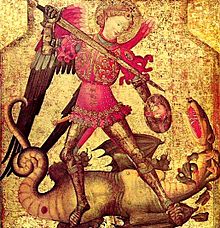Buckler (fist shield)
| Buckler (fist shield) | |
|---|---|

|
|
| Information | |
| Use: | Protective weapon |
| Creation time: | Around 13th century |
| Working time: | About the 13th century to about the 17th century |
| Region of origin / author: |
Europe , armory |
| Distribution: | Europe |
| Overall length: | Up to about 50 cm in diameter |
| Lists on the subject | |

A buckler is a special form of the fist shield . It is a small, mostly round shield that was used for personal defense in the Middle Ages . The name is associated with the shape of the buckler .
description
The name is derived from the shield boss , which was already to be found on Roman shields and describes the iron round part in the middle of the shield. The buckler found particular use in the 13th and 14th centuries, when it was used together with the one-handed sword on foot and also by the cavalry. Today it is believed that the buckler was used from the High Middle Ages to the Renaissance . The manuscript I.33 , a fencing book probably written in the late 13th century in southern Germany, contains only fighting techniques with one-handed sword and buckler and thus represents the most extensive single source for dealing with the buckler. With increasing armament technique, the buckler lost its importance, but appeared until in the 17th century regularly with various auxiliary weapons ( rapier , sword, dagger , knife ) on pictures of battles.
The buckler, although a weapon in itself, was far more than just a tool of defense. Often one finds in fencing books or contemporary battle pictures depictions in which the buckler was also used as a very effective weapon. The materials from which the Buckler was made varied widely. In some cases it was made entirely of metal, then again of wood with an iron shield boss; leather bucklers were occasionally used in fencing schools .
The diameter and shape of the shields were not always the same either. Above all in Hans Talhoffer's fencing book one finds an unusual shape with muzzle horns in the longitudinal direction of the hand (type III c). The size of the buckler varies and, according to Schmidt, has a maximum extension of 45 cm. Today's reconstructions usually level off exactly in the middle at about 30 to 35 cm. The fight with sword and buckler is reconstructed by various modern fencing groups (see web links). The interpretation of historical sources is not always clear, as medieval fencing books were often intended more as a memory aid for the author than as a didactic work.
Typology
According to Schmidt's typology, three types of bucklers are distinguished:
Type I: round
Type II: rectangular or trapezoidal
Type III: oval or teardrop-shaped
These types are combined with the cross section of the buckler.
Type a: flat
Type b: concave
Type c: convex
Type d: wavy
These are also used when the cross-section is only to be used in one direction.
The typology combines these two characteristics. A type Ia buckler would therefore be a round, flat buckler.
See also
literature
- Sword fight, the fight with the short sword and buckler according to the German school. Volume 2 , Wieland Verlag, Bad Aibling 2008, ISBN 978-3-938711-29-3 .
- Herbert Schmidt: Book of the Buckler. Wyvern Media, London, ISBN 978-0992991838 .
Web links
- Boar's Tooth Fight School - An historical martial arts club in Folkestone, Kent, England - engl.
- Arts of Mars - Historical European Martial Arts Academy
- Hammaborg - historical sword fight, Hamburg
- Ars Gladii, Dornbirn
- Steel on steel, Frankfurt aM
Individual evidence
- ^ Herbert Schmidt: Book of the Buckler . Wyvern Media, London, ISBN 978-0-9929918-3-8 .
- ^ Herbert Schmidt: Book of the Buckler . Wyvern Media, London, ISBN 978-0-9929918-3-8 .